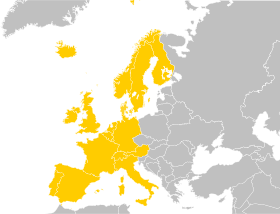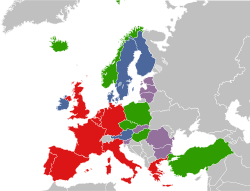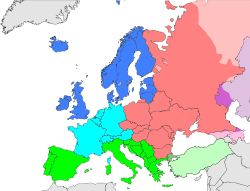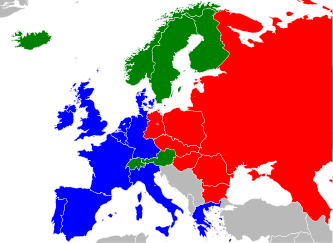Western Europe

Western Europe is a loose term for the collection of countries in the westernmost region of Europe, though this definition is context-dependent and carries cultural and political connotations. One definition describes Western Europe as a geographic entity — the region lying in the Western part of Europe. Another definition was created during the Cold War and used to describe the non-Communist states of Europe that were allied with the United States to some degree. As a result, geographically central and eastern countries that steered clear of Soviet influence during the Cold War are usually included, while western members of the former Eastern Bloc (with the exception of Eastern Germany) are excluded.
Countries described as Western European are invariably high-income developed countries, characterized by democratic political systems, mixed economies combining the free market with aspects of the welfare state, and are members of NATO.
Contents |
Classical antiquity and medieval origins
As Roman domain expanded, a cultural and linguistic division appeared between the mainly Greek-speaking eastern provinces which had formed the highly urbanized Hellenistic civilization. In contrast, the western territories largely adopted the Latin language. This cultural and linguistic division was eventually reinforced by the later political east-west division of the Roman Empire
The division between these two was enhanced during Late Antiquity and the Middle Ages by a number of events. The Western Roman Empire collapsed starting the Early Middle Ages. By contrast, the Eastern Roman Empire, mostly known as Greek or Byzantine Empire, managed to survive and even to thrive for another 1000 years. The rise of the Frankish Empire in the west, and in particular the Great Schism that formally divided Eastern Orthodoxy and Roman Catholicism, enhanced the cultural and religious distinctiveness between Eastern and Western Europe.
The conquest of the Byzantine Empire, center of the Eastern Orthodox Church, by the Muslim Ottoman Empire in the 15th century, and the gradual fragmentation of the Holy Roman Empire (which had replaced the Frankish Empire) led to a change of the importance of Roman Catholic/Protestant vs. Eastern Orthodox concept in Europe.
Western Europe's significant historical events include the Renaissance, the Protestant Reformation by Martin Luther and the Counter-Reformation of the Catholic Church, the Age of Enlightenment, the French Revolution and the Industrial Revolution. During the final stages of World War II the future of Europe was decided between the Allies in the 1945 Yalta Conference, between the British Prime Minister Winston Churchill, U.S. President Franklin Delano Roosevelt, and the Premier of the Soviet Union, Joseph Stalin.
Post-war Europe would be divided into two major spheres: the West, influenced by the United States, and the Eastern Bloc, dominated by the Soviet Union. With the onset of the Cold War, Europe was divided by the Iron Curtain.
This term had been used during World War II by German Propaganda Minister Joseph Goebbels and later Count Lutz Schwerin von Krosigk in the last days of the war; however, its use was hugely popularised by Winston Churchill, who used it in his famous "Sinews of Peace" address March 5, 1946 at Westminster College in Fulton, Missouri:
| “ | From Stettin in the Baltic to Trieste in the Adriatic an iron curtain has descended across the Continent. Behind that line lie all the capitals of the ancient states of Central and Eastern Europe. Warsaw, Berlin, Prague, Vienna, Budapest, Belgrade, Bucharest and Sofia; all these famous cities and the populations around them lie in what I must call the Soviet sphere, and all are subject, in one form or another, not only to Soviet influence but to a very high and in some cases increasing measure of control from Moscow. | ” |
Although some countries were officially neutral, they were classified according to the nature of their political and economical systems. This division has largely defined the popular perception and understanding of Western Europe and its borders with Eastern Europe till this day.
Eastern Europe
Eastern Europe, in the view accepted after the second World War, was mainly composed of all the European countries occupied by the Soviet army. It included the German Democratic Republic, widely known as East Germany, formed by the Soviet occupation zone of Germany. All the countries in Eastern Europe had Communist regimes imposed upon them. Most of these countries were officially independent from the Soviet Union, but the practical extent of this independence was quite limited. In some matters many of them were little more than client-states of the Soviet Union.
Currently, the borders of Eastern Europe are a topic of debate, especially because of the countries and people of Western culture,[2] identifying themselves with Central Europe and Northern Europe.
- Most of these countries were members of the military Warsaw pact and its economic twin COMECON. First and foremost was the Soviet Union (which included the modern-day territories of Russia, Estonia, Latvia, Lithuania, Belarus, Ukraine). Other countries dominated by the Soviet Union were the German Democratic Republic, Poland, Czechoslovakia, Hungary, Bulgaria, and Romania.
- The Socialist Federal Republic of Yugoslavia (formed after World War II and before its later dismemberment) was not a member of the Warsaw Pact. It was a founding member of the Non-Aligned Movement, an organization created in an attempt to avoid being assigned to any of the two blocs. It was demonstratively independent from the Soviet Union for most of the Cold War period, but because of its communist regime it was widely regarded part of the Eastern/communist bloc.
- Albania broke with the Soviet Union in the early 1960s as a result of the Sino-Soviet split, aligning itself instead with China. Despite this, it had a communist regime and thus was considered part of the Eastern/communist bloc.
Western Europe
Western Europe is composed of:
- Andorra
- Austria
- Belgium
- Denmark
- Finland
- France
- Germany
- Greece
- Iceland
- Ireland
- Italy
- Liechtenstein
- Luxembourg
- Malta
- Monaco
- Netherlands
- Norway
- Portugal
- San Marino
- Spain
- Sweden
- Switzerland
- United Kingdom
- Vatican City
Later political developments
|
Western European Union
Union de l'Europe occidentale |
||||
|---|---|---|---|---|
|
||||
 Members • Associate members • Observers • Associate partners
|
||||
| Membership | 10 member states 6 associate member states 5 observer countries 7 associate partner countries |
|||
| Establishment | Treaty of Brussels | |||
| - | Signed | 17 March 1948 | ||
The world changed dramatically with the fall of the Iron Curtain in 1989. The Federal Republic of Germany peacefully absorbed the German Democratic Republic, leading to the German reunification. COMECON and the Warsaw Pact were dissolved, and in 1991, the Soviet Union ceased to exist. Several countries which had been part of the Soviet Union regained their full independence.
Although the term Western Europe was largely defined of the Cold War, it still remains much in use. The term is commonly used in the media and in everyday use both in "western" and other regions of Europe.
Western Europe has increasingly less to do with the European Union. The 1995, 2004, and 2007 enlargements saw many post-Soviet countries joining the EU, and a view that Europe is divided strictly into the West and the East is sometimes considered patronising or pejorative by many in the countries of Central Europe and Northern Europe.
Present time
Definition used by the United Nations Statistics Division

The United Nations Statistics Division considers Western Europe to consist of the following nine countries,[3] except in the case of United Nations Regional Groups, in which the term also includes northern and southern Europe:
However, it should be noticed that this statistical division was designed during the Cold War period. According to the UN Statistics Division, the assignment of countries or areas to specific groupings is for statistical convenience and does not imply any assumption regarding political or other affiliation of countries or territories by the United Nations.[4]
Population of Western Europe
Countries of Western Europe as defined by the National Geographic Society.[1]
| Name of country, with flag | Population (2009 est.) |
Population (2000 est.) |
-/+ of Population | Percent change | Capital |
|---|---|---|---|---|---|
| 8,355,260 | 8,002,186 | 353,074 | 4.33% | Vienna | |
| 10,665,867 | 10,296,350 | 369,517 | 3.46% | Brussels | |
| 5,511,451 | 5,330,020 | 181,431 | 3.30% | Copenhagen | |
| 5,244,749 | 5,167,486 | 77,263 | 1.58% | Helsinki | |
| 64,351,000 | 60,537,977 | 3,813,023 | 6.03% | Paris | |
| 82,002,356 | 82,163,475 | -161,119 | -0.11% | Berlin | |
| 319,368 | 279,049 | 40,319 | 12.73% | Reykjavík | |
| 4,465,540 | 3,777,763 | 687,777 | 15.51% | Dublin | |
| 60,053,442 | 56,923,524 | 3,129,918 | 5.32% | Rome | |
| 493,500 | 433,600 | 59,900 | 12.24% | Luxembourg | |
| 16,486,587 | 15,863,950 | 622,637 | 3.88% | Amsterdam | |
| 4,799,252 | 4,478,497 | 320,755 | 6.79% | Oslo | |
| 10,627,250 | 10,195,014 | 432,236 | 4.17% | Lisbon | |
| 46,661,950 | 40,049,708 | 6,612,242 | 12.71% | Madrid | |
| 9,256,347 | 8,861,426 | 394,921 | 4.37% | Stockholm | |
| 7,700,202 | 7,1624,444 | 535,758 | 7.06% | Bern | |
| 61,634,599 | 58,785,246 | 2,849,353 | 4.73% | London | |
| Total | 397,475,574 | 378,309,715 | 19,519,387 | 4.82% |
See also
- Western European Union
- Western world
- First World
- New Europe
- Old Europe
- Marshall Plan
- Eastern Europe
- Central Europe
- Northern Europe
- Romano-Germanic culture
References and notes
- ↑ 1.0 1.1 "Western Europe". National Geographic Society. NationalGeographic.com. 2009. http://travel.nationalgeographic.com/places/regions/region_westeurope.html. Retrieved 2009-09-28.
- ↑ O. Halecki, The Limits and Divisions of European History, Sheed & Ward, London and New York 1950, Chapter VII
- ↑ United Nations Statistics Division – Composition of macro geographical (continental) regions, geographical sub-regions, and selected economic and other groupings
- ↑ http://unstats.un.org/unsd/methods/m49/m49.htm
- The Making of Europe, ISBN 0-14-015409-4, by Robert Bartlett
- Crescent and Cross, ISBN 1-84212-753-5, by Hugh Bicheno
- The Normans, ISBN 0-7524-2881-0, by Trevor Rowley
- 1066 The Year of the Three Battles, ISBN 0-7126-6672-9, by Frank McLynn
External links
|
|||||||||||||||||||||||||||||||||||||
|
||||||||||||||||||||||||||||||||

